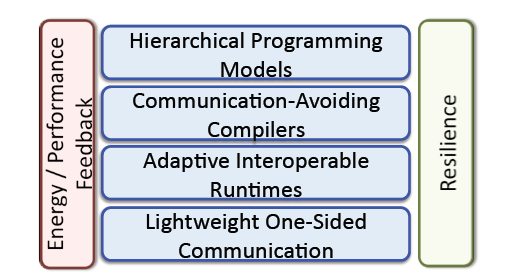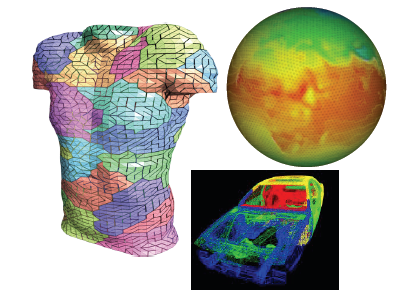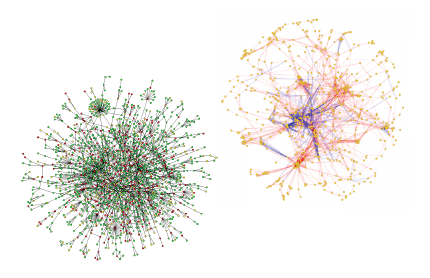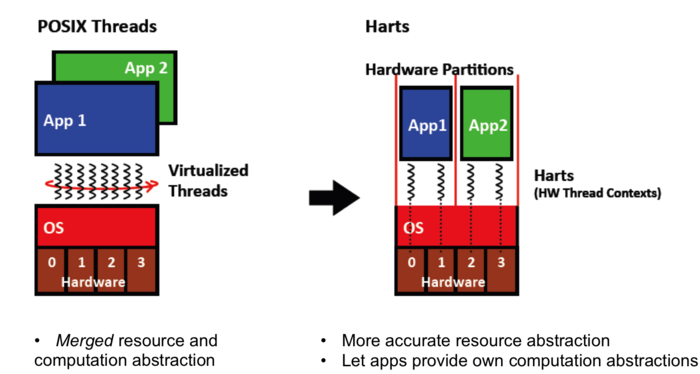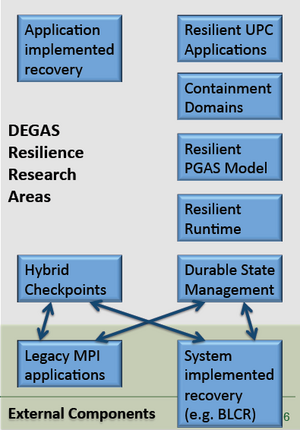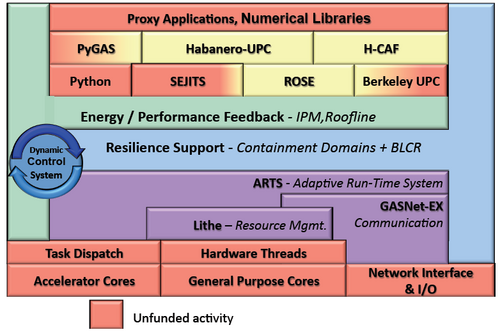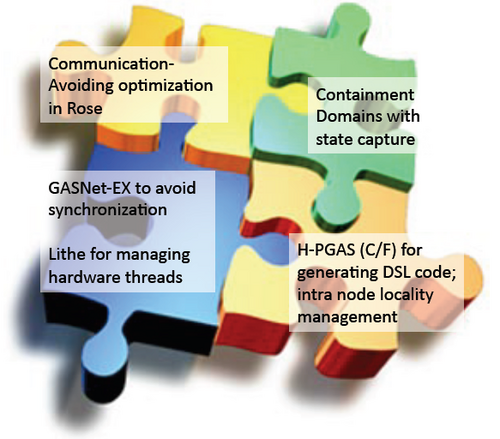DEGAS
From Modelado Foundation
| DEGAS | |
|---|---|
| File:Your-team-logo.png | |
| Team Members | LBNL, Rice U., UC Berkeley, UT Austin, LLNL, NCSU |
| PI | Katherine Yelick (LBNL)) |
| Co-PIs | Vivek Sarkar (Rice U.), James Demmel (UC Berkeley),
Mattan Erez (UT Austin), Dan Quinlan (LLNL) |
| Website | team website |
| Download | {{{download}}} |
Description about your project goes here.....
Team Members
- Lawrence Berkeley National Laboratory (LBNL)
- Rice University
- University of California, Berkeley
- University of Texas at Austin
- Lawrence Livermore National Laboratory (LLNL)
- North Carolina State University (NCSU)
Mission
Mission Statement: To ensure the broad success of Exascale systems through a unified programming model that is productive, scalable, portable, and interoperable, and meets the unique Exascale demands of energy efficiency and resilience.
Goals & Objectives
- Scalability: Billion‐way concurrency, thousand‐way on chip with new architectures
- Programmability: Convenient programming through a global address space and high‐level abstractions for parallelism, data movement and resilience
- Performance Portability: Ensure applications can be moved across diverse machines using implicit (automatic) compiler optimizations and runtime adaptation
- Resilience: Integrated language support for capturing state and recovering from faults
- Energy Efficiency: Avoid communication, which will dominate energy costs, and adapt to performance heterogeneity due to system-‐level energy management
- Interoperability: Encourage use of languages and features through incremental adoption
Programming Models
Two Distinct Parallel Programming Questions
- What is the parallel control model?
- What is the model for sharing/communication?
Applications Drive New Programming Models
- Message Passing Programming
- Divide up domain in pieces
- Compute one piece and exchange
- MPI and many libraries
- Global Address Space Programming
- Each start computing
- Grab whatever/whenever
- UPC, CAF, X10, Chapel, Fortress, Titanium, GlobalArrays
Hierarchical Programming Model
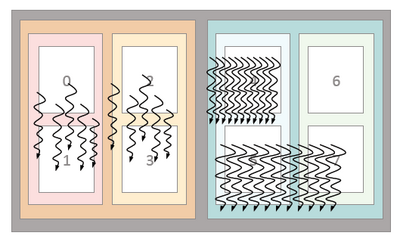
- Goal: Programmability of exascale applications while providing scalability, locality, energy efficiency, resilience, and portability
- Implicit constructs: parallel multidimensional loops, global distributed data structures, adaptation for performance heterogeneity
- Explicit constructs: asynchronous tasks, phaser synchronization, locality
- Built on scalability, performance, and asynchrony of PGAS models
- Language experience from UPC, Habanero‐C, Co‐Array Fortran, Titanium
- Both intra and inter‐node; focus is on node model
- Languages demonstrate DEGAS programming model
- Habanero‐UPC: Habanero’s intra‐node model with UPC’s inter‐node model
- Hierarchical Co‐Array Fortran (CAF): CAF for on‐chip scaling and more
- Exploration of high level languages: E.g., Python extended with H‐PGAS
- Language‐independent H‐PGAS Features:
- Hierarchical distributed arrays, asynchronous tasks, and compiler specialization for hybrid (task/loop) parallelism and heterogeneity
- Semantic guarantees for deadlock avoidance, determinism, etc.
- Asynchronous collectives, function shipping, and hierarchical places
- End‐to‐end support for asynchrony (messaging, tasking, bandwidth utilization through concurrency)
- Early concept exploration for applications and benchmarks
Communication-Avoiding Compilers
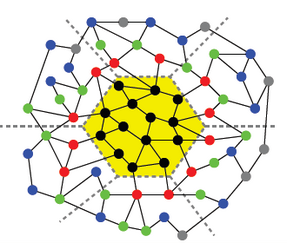
- Goal: massive parallelism, deep memory and network hierarchies, plus functional and performance heterogeneity
- Fine‐grained task and data parallelism: enable performance portability
- Heterogeneity: guided by functional, energy and performance characteristics
- Energy efficiency: minimize data movement and hooks to runtime adaptation
- Programmability: manage details of memory, heterogeneity, and containment
- Scalability: communication and synchronization hiding through asynchrony
- H-PGAS into the Node
- Communication is all data movement
- Build on code‐generation infrastructure
- ROSE for H‐CAF and Communication‐Avoidance optimizations
- BUPC and Habanero‐C; Zoltan
- Additional theory of CA code generation
Exascale Programming: Support for Future Algorithms
- Approach: “Rethink” algorithms to optimize for data movement
- New class of communication‐optimal algorithms
- Most codes are not bandwidth limited, but many should be
- Challenges: How general are these algorithms?
- Can they be automated and for what types of loops?
- How much benefit is there in practice?
Adaptive Runtime Systems (ARTS)
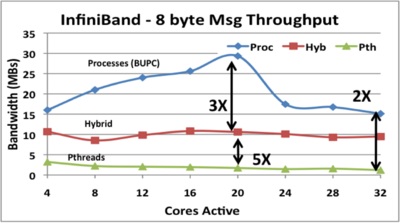
- Goal: Adaptive runtime for manycore systems that are hierarchical, heterogeneous and provide asymmetric performance
- Reactive and proactive control: for utilization and energy efficiency
- Integrated tasking and communication: for hybrid programming
- Sharing of hardware threads: required for library interoperability
- Novelty: Scalable control; integrated tasking with communication
- Adaptation: Runtime annotated with performance history/intentions
- Performance models: Guide runtime optimizations, specialization
- Hierarchical: Resource/energy
- Tunable control: Locality/load balance
- Leverages: Existing runtimes
- Lithe scheduler composition; Juggle
- BUPC and Habanero‐C runtimes
Synchronization Avoidance vs Resource Management
- Management of critical resources will be more important:
- Memory and network bandwidth limited by cost and energy
- Capacity limited at many levels: network buffers at interfaces, internal network congestion are real and growing problems
- Can runtimes manage these or do users need to help?
- Adaptation based on history and (user‐supplied) intent?
- Where will bottlenecks be for a given architecture and application?
Lith Scheduling Abstraction: "Harts" (Hardware Threads)
Lightweight Communication (GASNet-EX)
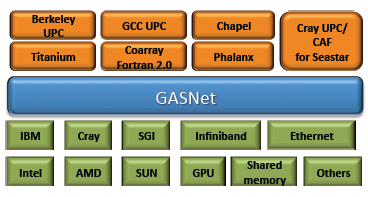
- Goal: Maximize bandwidth use with lightweight communication
- One‐sided communication: to avoid over‐synchronization
- Active‐Messages: for productivity and portability
- Interoperability: with MPI and threading layers
- Novelty:
- Congestion management: for 1‐sided communication with ARTS
- Hierarchical: communication management for H‐PGAS
- Resilience: globally consist states and fine‐grained fault recovery
- Progress: new models for scalability and interoperatbility
- Leverage GASNet (redesigned):
- Major changes for on‐chip interconnects
- Each network has unique opportunities
Resilience through Containment Domains

- Goal: Provide a resilient runtime for PGAS applications
- Applications should be able to customize resilience to their needs
- Resilient runtime that provides easy‐to‐use mechanisms
- Novelty: Single analyzable abstraction for resilience
- PGAS Resilience consistency model
- Directed and hierarchical preservation
- Global or localized recovery
- Algorithm and system‐specific detection, elision, and recovery
- Leverage: Combined superset of prior approaches
- Fast checkpoints for large bulk updates
- Journal for small frequent updates
- Hierarchical checkpoint‐restart
- OS‐level save and restore
- Distributed recovery
Resilience: Research Questions
1. How to define consistent (i.e. allowable) states in the PGAS model?
- Theory well understood for fail‐stop message‐passing, but not PGAS.
2. How do we discover consistent states once we've defined them?
- Containment domains offer a new approach, beyond conventional sync-and‐stop algorithms.
3. How do we reconstruct consistent states after a failure?
- Explore low overhead techniques that minimize effort required by applications programmers.
- Leverage BLCR, GASnet, Berkeley UPC for development, and use Containment Domains as prototype API for requirements discovery
Energy and Performance Feedback
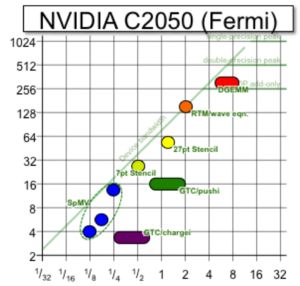
- Goal: Monitoring and feedback of performance and energy for online and offline optimization
- Collect and distill: performance/energy/timing data
- Identify and report bottlenecks: through summarization/visualization
- Provide mechanisms: for autonomous runtime adaptation
- Novelty: Automated runtime introspection
- Provide monitoring: power/network utilization
- Machine Learning: identify common characteristics
- Resource management: including dark silicon
- Leverage: Performance/energy counters
- Integrated Performance Monitoring (IPM)
- Roofline formalism
- Performance/energy counters
Software Stack
